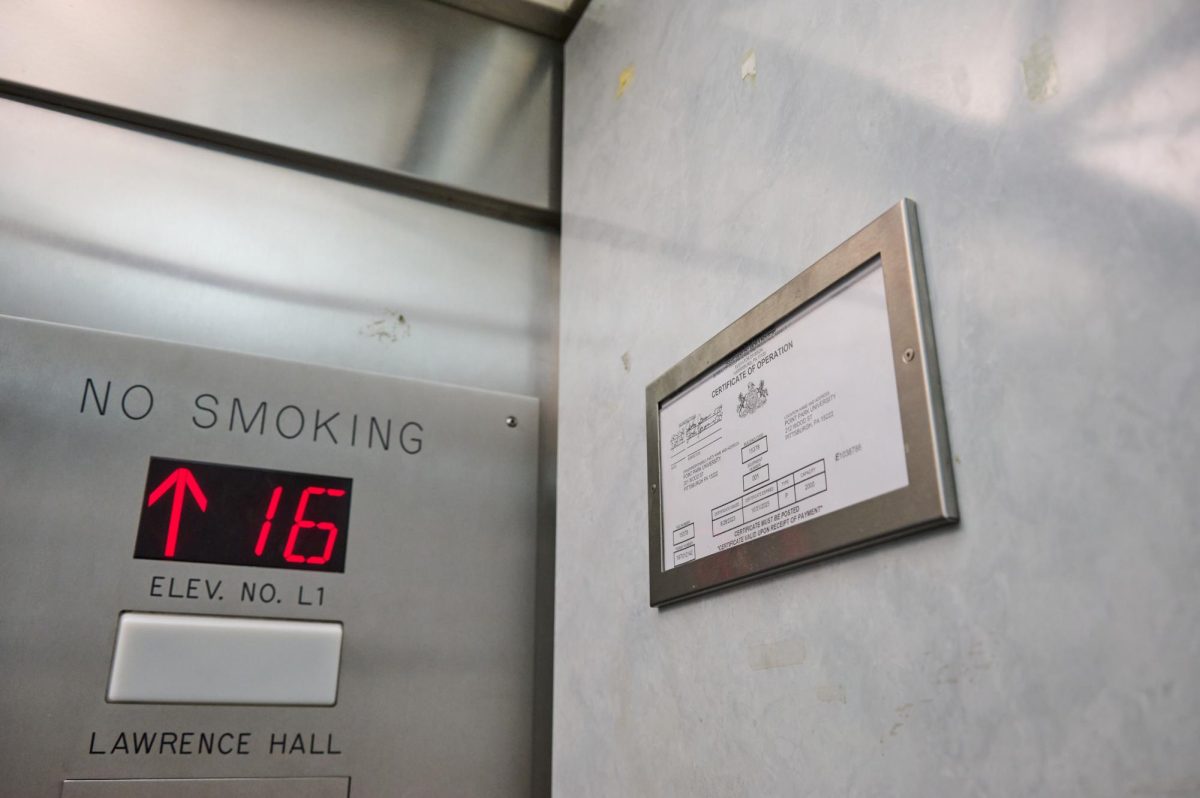Point Park is a vertical campus, which can require students to utilize one or many of the elevators across campus every day. Some students, however, are weary of using them.
“I’m slightly bothered by knowing that some of them are running on expired tags,” Austyn Carte, a first-year criminal justice major, said.
The expired tags Carte is referring to are the certificates displayed inside all elevators across campus.
Point Park is one of the few institutions Downtown that displays the certificates in the elevators. Most other institutions keep the certificates in the facility’s office, according to Chris Hill, Physical Plant’s vice president of operations.
“We do it to show the students that [inspections are] being done,” Hill said.
Though the displayed certificates are expired, this is because the new ones have not arrived from the state yet. Hill said that Point Park keeps the expired certificates displayed because the ID numbers on the certificates would allow students to call the state and verify they are up to date.
The certificates have since been updated in the elevators.
Chandler Bigley, a first-year broadcast student, said he is also weary of taking the elevator at Point Park.
“They’re loud, so I don’t trust them,” Bigley said. “Also, I’ve seen them bounce.”
Another issue with the elevators is that they are known to get stuck on floors. There are two big causes for this.
One cause is simply due to overcrowding. If the weight inside is 10% above or below the max limit, the elevator won’t move. This means someone has to get off for the elevator to move.
Another common cause of the elevator getting stuck is referred to as “the nudge.” This is when someone puts their arm out when the elevator door is closing, causing the elevator to hit their arm and open.
If this is done three times, the elevator’s control system believes something is wrong. This will cause the elevator to shut down. The only way to get the elevator up and running after it shuts down is to have the staff reset it.
“If someone is coming, use the button, not the nudge,” Hill said. “Then, the elevator knows it’s coming for somebody who is trying to hold the door.”
Additionally, if the doors cannot close due to people blocking them, the elevator will go into nudge mode, which nudges people out of the way. While this happens, the elevator’s buzzer or beeper will sound, indicating that people need to step clear of the doors.
Hill and Safety Manager Kelly Staschak of the Physical Plant, provided 10 elevator safety tips for students who are weary.
First, be careful of the doors. Though they usually retract when they hit an object, the pressure can still be painful.
Do not continuously put your arm in the way of the elevator closing, because after three times, it will need to be reset.
To open the doors and let others on, hold or push the door open button. Doing that is an easy and safe way to let other passengers on to the elevator.
Avoid overloading the elevator. If it looks crowded, it probably is, so it’s best to wait for the next car.

Another simple tip is to not horseplay on the elevators. This includes jumping while the elevator is in motion, slamming the walls or hitting the alarm bell for no given reason.
Not only can jumping on a moving elevator put unnecessary stress on the cables and pulleys, but most modern elevators have sensors to detect jumps. According to Elevator World, a website for elevator technician news, magnetic sensors are used to detect the speed of the elevator and to make sure it is balanced. They will stop the elevator mid-floor if a jump is detected, requiring a maintenance worker to reset the elevator.
Never use an elevator during a possible fire emergency. Always use the stairs when the fire alarm is activated. All buildings on campus have elevator systems that are synced with the fire alarm panels. Because of this, the elevators know when a fire alarm is activated and will automatically go down to the lobby floor.
Do not climb out the roof hatch or pry open the elevator doors unless it is a life-threatening emergency.
Do not panic. If the elevator is stopped, the safest place to be is in the elevator car. It also allows professionals to assist as safely and quickly as possible. According to Pittsburgh Fire Rescue dispatchers, during move-in week on August 22, an elevator in the Boulevard Apartments got stuck on the first floor. Everyone inside was freed with no injuries.
Do not be a hero. The safest thing to do if you are stuck in the elevator is to wait for help. If someone is panicking, try to talk to them instead of trying to get them out by yourself. Stepping out of the elevator on your own can create the risk of being trapped between the doors.
Lastly, if you find yourself stuck in the elevator, use the elevator alarm or emergency call button to ask for help. Each elevator on campus has a working phone inside.
In general, there are very few major problems that happen with the elevators.
“I think for the amount of times it’s used, there a very few what I’m going to call real issues, where a motor goes or something like that,” Hill said.
However, in the event of an emergency, call Point Park Public Safety at 412-392-3960 or use the phone built into the elevator.







